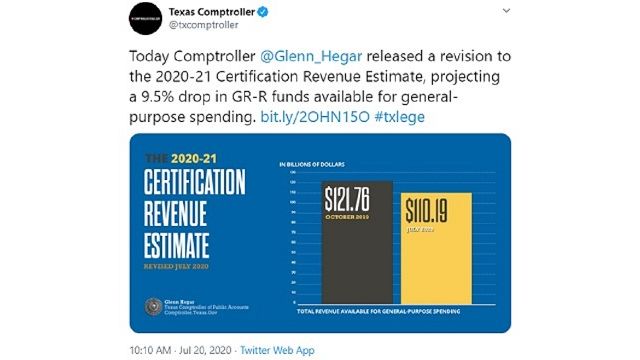
Events related to the pandemic result in the Texas state comptroller projecting there will be $11.57 billion less money for the legislature to use in general purpose spending during the 2020-2021 biennium.
Glenn Hegar sent a letter to state leaders Monday projecting $110.19 billion dollars in general revenue related funds. That’s down from his projection last October of $121.76 billion.
Hegar says those numbers do not take into account the orders given to most state agencies to reduce their spending by five percent.
Hegar also announced a negative swing of $7.47 billion in projected revenue collections for the 2021 fiscal year…from a surplus of $2.89 billion to a shortfall of $4.58 billion.
From the Texas comptroller’s office:
Texas Comptroller Glenn Hegar today revised the Certification Revenue Estimate (CRE) and now projects a fiscal 2021 ending shortfall of $4.58 billion. The shortfall, which Hegar attributed to the COVID-19 pandemic and recent volatility in oil prices, is a decrease from the $2.89 billion positive year-end balance originally projected in the October 2019 CRE.
In a July 20 letter to state leadership, Hegar said the state will have $110.19 billion in General Revenue-related (GR-R) funds available for general-purpose spending for the 2020-21 biennium, down from a projected $121.76 billion in the October 2019 CRE.
The ending balance does not include the impact of instructions from state leadership directing most agencies to reduce their spending by 5 percent of 2020-21 GR-R appropriations. Any of these savings will reduce the projected shortfall. Similarly, the balance also does not assume any further financial assistance from the federal government as both the prospect and nature of such assistance remain uncertain.
“The economic contraction associated with COVID-19 has resulted in revenue collections this fiscal year that are much lower than our earlier CRE projections,” Hegar said. “It’s important to note that this revised estimate carries unprecedented uncertainty. We’re assuming the state will effectively manage the outbreak and that infection rates won’t overwhelm our health care system. This estimate also assumes that restrictions on businesses and individuals will be lifted before the end of this calendar year and that economic activity will strengthen but not return to pre-pandemic levels by the end of this biennium.”
The pandemic hit tax revenues hard across the board, particularly hotel, motor vehicle sales, severance and mixed beverage taxes. The state’s sales tax, its largest source of tax revenue, has held up better than some taxes, but still has fallen significantly. Fiscal 2020’s sales tax revenues, buoyed by strong collections in the first half of the year, are expected to finish about 1 percent below fiscal 2019 totals, followed by a drop of more than 4 percent in fiscal 2021.
The Economic Stabilization Fund (ESF, or the state’s “Rainy Day Fund”) and the State Highway Fund (SHF) both receive funding from oil and natural gas severance taxes. In fiscal 2021, the ESF and SHF each will receive $1.1 billion in transfers from the General Revenue Fund for severance taxes collected in fiscal 2020. Severance tax collections in fiscal 2021 are expected to drop significantly from fiscal 2020, resulting in smaller fiscal 2022 transfers to the ESF and SHF of about $620 million each.
After accounting for appropriations and investment and interest earnings, this estimate projects an ESF fiscal 2021 ending balance of $8.79 billion.
Proposition 7, an amendment to the Texas Constitution approved by Texas voters in 2015, requires the first $2.5 billion in sales tax collections exceeding $28 billion in any fiscal year to be deposited to the SHF. The SHF will receive $2.5 billion from sales taxes collected in each year of the biennium, although the final transfer from fiscal 2021 collections will not occur until September 2021, the first month of fiscal 2022.
“In the coming months, some economic indicators will establish new records for rates of growth, but those records will be on the back of this year’s unprecedented declines,” Hegar said. “The rebound will leave many measures of economic health below pre-pandemic levels. Consumers and businesses must be confident the virus is controlled before economic output, employment and revenues return to pre-pandemic levels.”
There are substantial risks to this forecast on both the upside and downside. If the spread of the virus slows or stops sooner than anticipated, if consumers and businesses return to pre-pandemic levels of economic activity more readily than assumed or if the federal government provides more aid, Texas may finish the 2020-21 biennium with more revenue than projected today. On the other hand, if COVID-19 case counts continue to increase or accelerate, if there is a substantial new wave of infections nationally or in Texas in the fall or winter or if consumers and businesses are slower to resume economic activity than assumed, revenue collected this biennium could fall short, perhaps far short, of this updated forecast.
